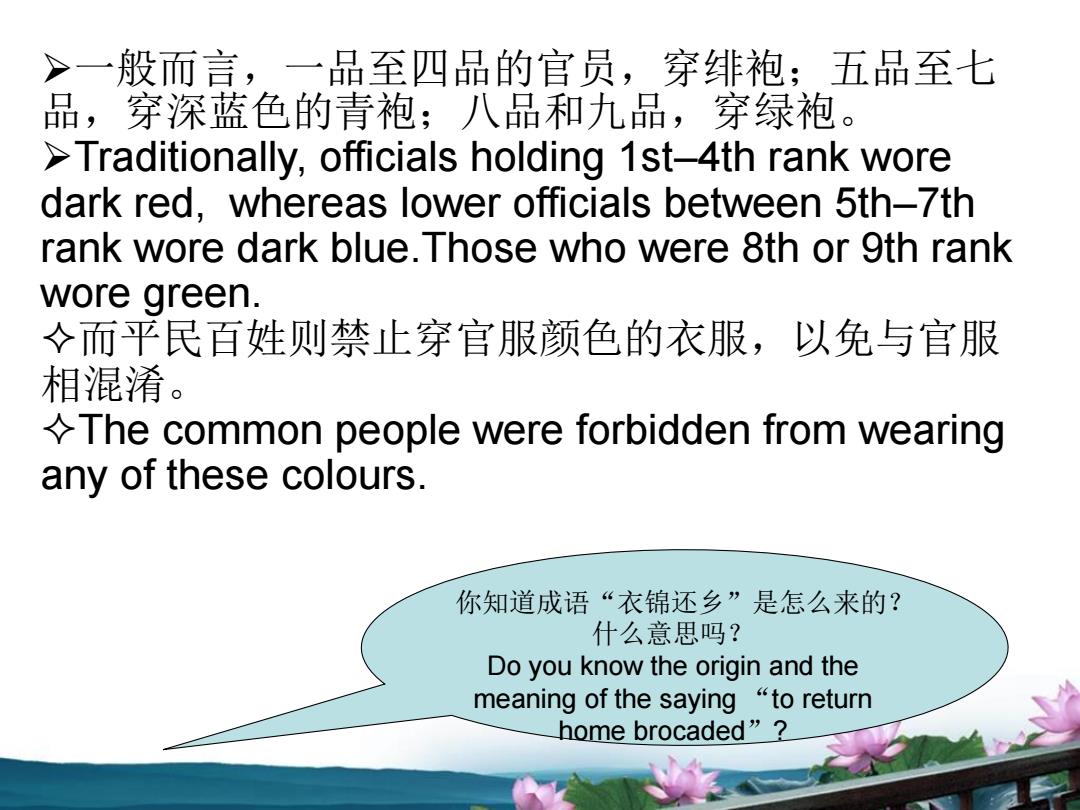
>一般而言,一品至四品的官员,穿绯袍;五品至七 品,穿深蓝色的青袍;八品和九品,穿绿袍。 >Traditionally,officials holding 1st-4th rank wore dark red,whereas lower officials between 5th-7th rank wore dark blue.Those who were 8th or 9th rank wore green. ◇而平民百姓则禁止穿官服颜色的衣服,以免与官服 相混淆。 The common people were forbidden from wearing any of these colours. 你知道成语“衣锦还乡”是怎么来的? 什么意思吗? Do you know the origin and the meaning of the saying "to return home brocaded”?
你知道成语“衣锦还乡”是怎么来的? 什么意思吗? Do you know the origin and the meaning of the saying “to return home brocaded”? 一般而言,一品至四品的官员,穿绯袍;五品至七 品,穿深蓝色的青袍;八品和九品,穿绿袍。 Traditionally, officials holding 1st–4th rank wore dark red, whereas lower officials between 5th–7th rank wore dark blue.Those who were 8th or 9th rank wore green. 而平民百姓则禁止穿官服颜色的衣服,以免与官服 相混淆。 The common people were forbidden from wearing any of these colours
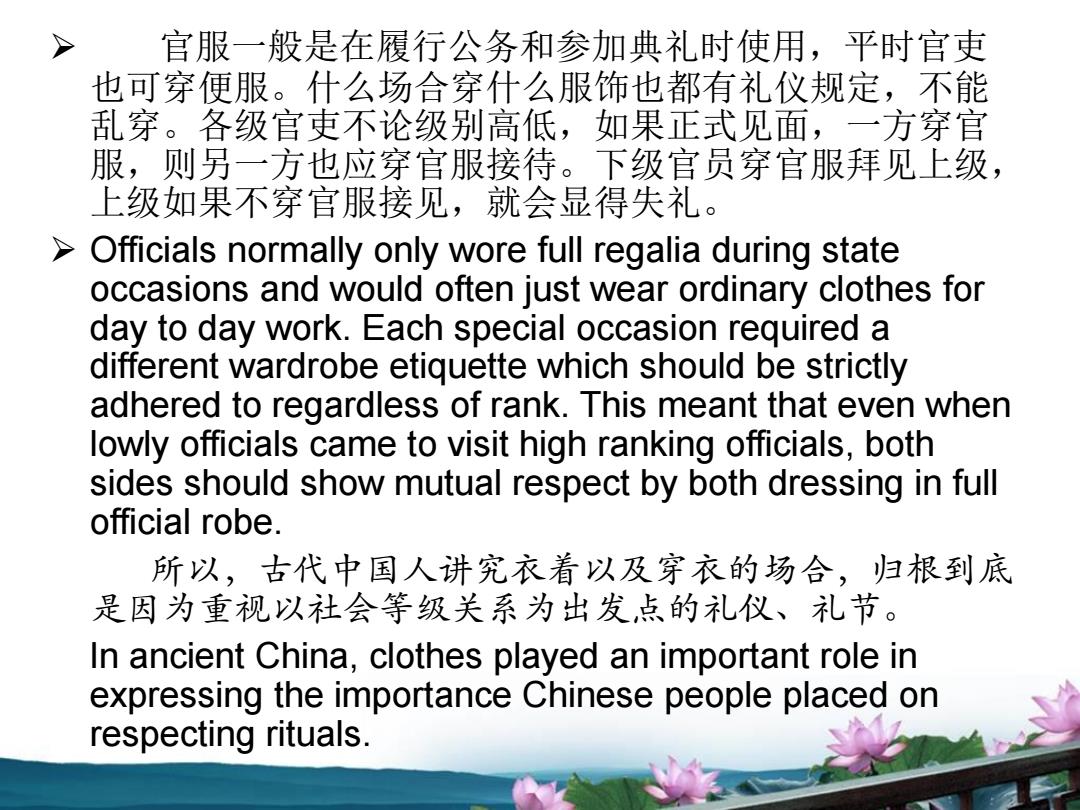
> 官服一般是在履行公务和参加典礼时使用,平时官吏 也可穿便服。什么场合穿什么服饰也都有礼仪规定,不能 乱穿。各级官吏不论级别高低,如果正式见面,一方穿官 服,则另一方也应穿官服接待。下级官员穿官服拜见上级, 上级如果不穿官服接见,就会显得失礼。 Officials normally only wore full regalia during state occasions and would often just wear ordinary clothes for day to day work.Each special occasion required a different wardrobe etiquette which should be strictly adhered to regardless of rank.This meant that even when lowly officials came to visit high ranking officials,both sides should show mutual respect by both dressing in full official robe. 所以,古代中国人讲究衣着以及穿衣的场合,归根到底 是因为重视以社会等级关系为出发点的礼仪、礼节。 In ancient China,clothes played an important role in expressing the importance Chinese people placed on respecting rituals
官服一般是在履行公务和参加典礼时使用,平时官吏 也可穿便服。什么场合穿什么服饰也都有礼仪规定,不能 乱穿。各级官吏不论级别高低,如果正式见面,一方穿官 服,则另一方也应穿官服接待。下级官员穿官服拜见上级, 上级如果不穿官服接见,就会显得失礼。 Officials normally only wore full regalia during state occasions and would often just wear ordinary clothes for day to day work. Each special occasion required a different wardrobe etiquette which should be strictly adhered to regardless of rank. This meant that even when lowly officials came to visit high ranking officials, both sides should show mutual respect by both dressing in full official robe. 所以,古代中国人讲究衣着以及穿衣的场合,归根到底 是因为重视以社会等级关系为出发点的礼仪、礼节。 In ancient China, clothes played an important role in expressing the importance Chinese people placed on respecting rituals
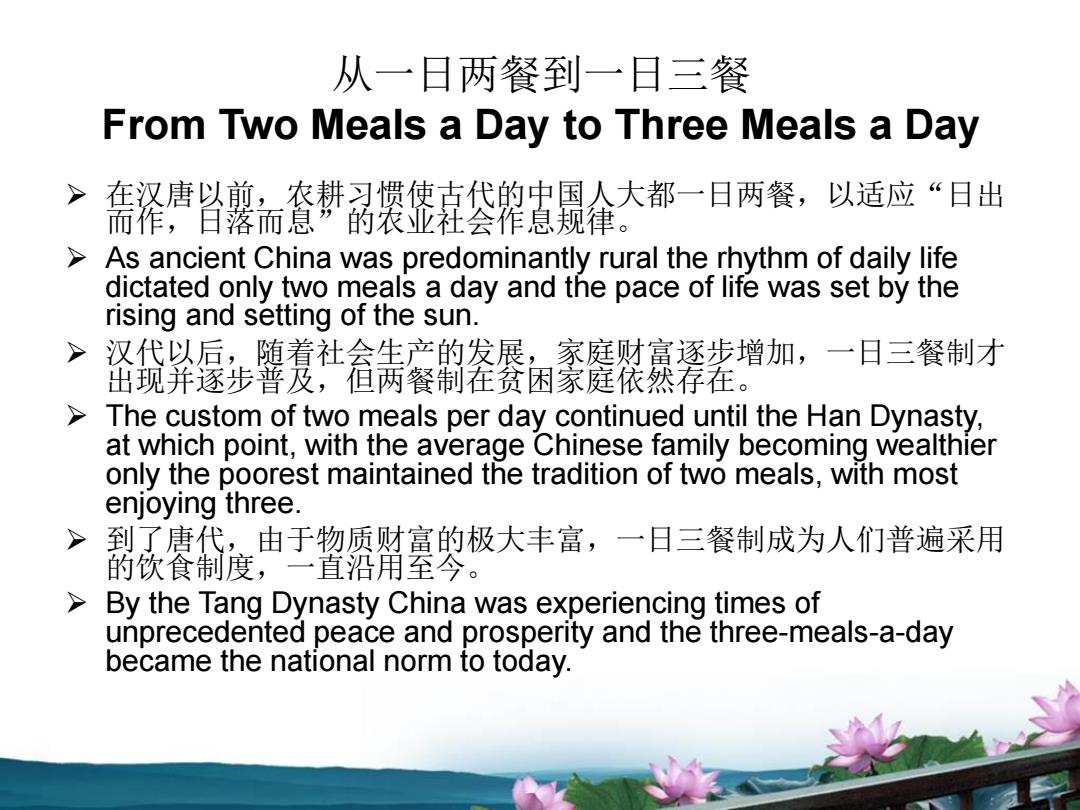
从一日两餐到一日三餐 From Two Meals a Day to Three Meals a Day 在汉唐以前,农耕习惯使古代的中国人大都一日两餐,以适应“日出 而作,日落而息”的农亚衽会作息规律。 As ancient China was predominantly rural the rhythm of daily life dictated only two meals a day and the pace of life was set by the rising and setting of the sun. 汉代以后,随着社会生产的发展,家庭财富逐步增加,一日三餐制才 出现并逐步普及,但两餐制在贫困家庭依然存在。 The custom of two meals per day continued until the Han Dynasty, at which point,with the average Chinese family becoming wealthier only the poorest maintained the tradition of two meals,with most enjoying three. > 到了唐代,由于物质财富的极大丰富,一日三餐制成为人们普遍采用 的饮食制度,一直沿用至今。 > By the Tang Dynasty China was experiencing times of unprecedented peace and prosperity and the three-meals-a-day became the national norm to today
从一日两餐到一日三餐 From Two Meals a Day to Three Meals a Day 在汉唐以前,农耕习惯使古代的中国人大都一日两餐,以适应“日出 而作,日落而息”的农业社会作息规律。 As ancient China was predominantly rural the rhythm of daily life dictated only two meals a day and the pace of life was set by the rising and setting of the sun. 汉代以后,随着社会生产的发展,家庭财富逐步增加,一日三餐制才 出现并逐步普及,但两餐制在贫困家庭依然存在。 The custom of two meals per day continued until the Han Dynasty, at which point, with the average Chinese family becoming wealthier only the poorest maintained the tradition of two meals, with most enjoying three. 到了唐代,由于物质财富的极大丰富,一日三餐制成为人们普遍采用 的饮食制度,一直沿用至今。 By the Tang Dynasty China was experiencing times of unprecedented peace and prosperity and the three-meals-a-day became the national norm to today
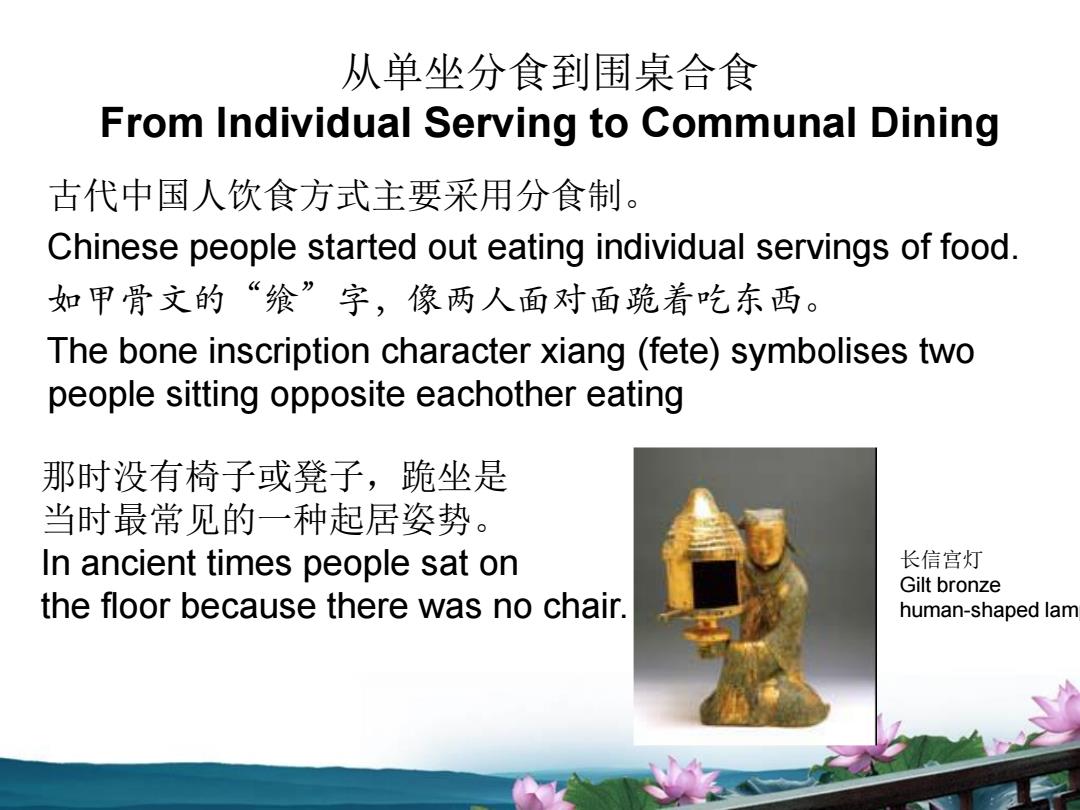
从单坐分食到围桌合食 From Individual Serving to Communal Dining 古代中国人饮食方式主要采用分食制。 Chinese people started out eating individual servings of food. 如甲骨文的“飨”字,像两人面对面跪着吃东西。 The bone inscription character xiang (fete)symbolises two people sitting opposite eachother eating 那时没有椅子或凳子,跪坐是 当时最常见的一种起居姿势。 In ancient times people sat on 长信宫灯 Gilt bronze the floor because there was no chair. human-shaped lam
从单坐分食到围桌合食 From Individual Serving to Communal Dining 古代中国人饮食方式主要采用分食制。 Chinese people started out eating individual servings of food. 如甲骨文的“飨”字,像两人面对面跪着吃东西。 The bone inscription character xiang (fete) symbolises two people sitting opposite eachother eating 长信宫灯 Gilt bronze human-shaped lamp 那时没有椅子或凳子,跪坐是 当时最常见的一种起居姿势。 In ancient times people sat on the floor because there was no chair
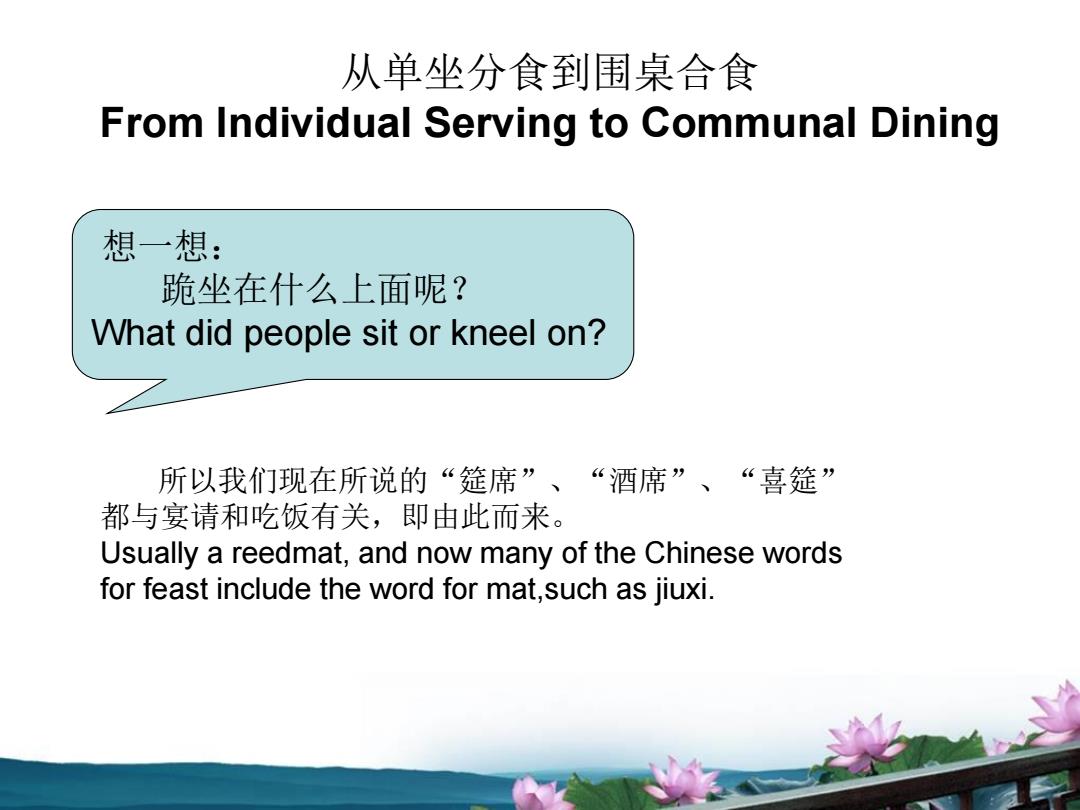
从单坐分食到围桌合食 From Individual Serving to Communal Dining 想一想: 跪坐在什么上面呢? What did people sit or kneel on? 所以我们现在所说的“筵席”、“酒席”、“喜筵” 都与宴请和吃饭有关,即由此而来。 Usually a reedmat,and now many of the Chinese words for feast include the word for mat,such as jiuxi
从单坐分食到围桌合食 From Individual Serving to Communal Dining 想一想: 跪坐在什么上面呢? What did people sit or kneel on? 所以我们现在所说的“筵席”、“酒席”、“喜筵” 都与宴请和吃饭有关,即由此而来。 Usually a reedmat, and now many of the Chinese words for feast include the word for mat,such as jiuxi